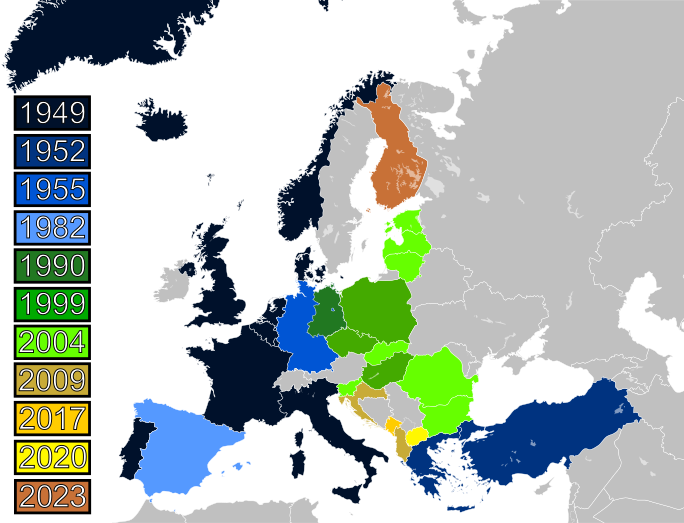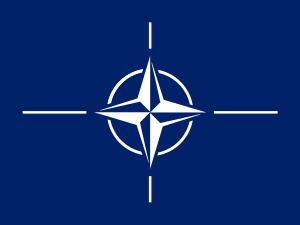Enlargement of NATO facts for kids
NATO is a team of countries from Europe and North America. There are currently thirty-two countries in this team. They work together to protect each other, which is called "collective defense." This means if one country in NATO is attacked, all the other countries promise to help defend it.
NATO started in 1949 with twelve founding members. Over the years, more countries have joined, making the team bigger. The first countries to join after 1949 were Greece and Turkey in 1952. In 1955, West Germany joined NATO. This led to the Soviet Union forming its own group, often called the Warsaw Pact, later that same month. After becoming a democracy, Spain chose to join NATO in 1982.
In 1990, when Germany became one country again, it stayed in NATO. After the Soviet Union broke up in 1991, many countries that used to be part of the Soviet Union or the Warsaw Pact wanted to join NATO. Poland, Hungary, and the Czech Republic became NATO members in 1999. NATO then created a special plan called the "Membership Action Plan" to help other countries join. This plan helped seven countries from Central and Eastern Europe join in 2004: Bulgaria, Estonia, Latvia, Lithuania, Romania, Slovakia, and Slovenia.
Two countries on the Adriatic Sea, Albania and Croatia, joined in 2009. The next countries to join were Montenegro in 2017 and North Macedonia in 2020. Finland joined in 2023, and Sweden joined in 2024. Other countries like Ukraine, Bosnia and Herzegovina, Georgia, and Kosovo have also said they want to join NATO in the future.
Contents
How Countries Join NATO
The Rules for Joining
The main rulebook for NATO is called the North Atlantic Treaty. Any changes, including adding new members, must be agreed upon by all current member countries. Article 10 of this treaty explains how new countries can join NATO.
It says that NATO members can all agree to invite "any other European State" to join. This country must be able to support the ideas of the treaty and help keep the North Atlantic area safe. Once invited, a country officially joins by giving its agreement to the United States government.
So, there are two main rules for new members:
- They must be European countries.
- All current NATO members must agree to invite them.
In the past, some disagreements have slowed down new members. For example, Greece stopped the Republic of Macedonia from joining for many years because they disagreed about its name. Turkey also has concerns about Cyprus joining NATO activities because of an ongoing dispute.
Since 1991, NATO has made it clearer what countries need to do to join. A study in 1995 said that new members should have: "democracy, individual liberty, and rule of law." This means they should be fair, respect people's freedoms, and follow laws. It's also generally understood that countries should not have ongoing land disagreements with other countries when they join.
The Membership Action Plan
A big step in making the joining process clear was the "Membership Action Plan" (MAP), created in 1999. This plan helps NATO members regularly check on countries that want to join.
When a country joins MAP, it presents yearly reports on its progress in five areas:
- Being willing to solve international problems peacefully.
- Having a strong commitment to fair laws, human rights, and democratic control over its military.
- Being able to help with NATO's defense and missions.
- Spending enough money on its military to meet the promises of being a member.
- Making sure its own laws work well with NATO's rules.
NATO gives advice and feedback to each country. Once all members agree that a country meets the requirements, NATO can invite it to start the final steps to join.
Many countries have used the MAP to join NATO. For example, Bulgaria, Estonia, Latvia, Lithuania, Romania, Slovakia, and Slovenia all joined in 2004 after being part of MAP. Albania and Croatia joined in 2009, Montenegro in 2017, and North Macedonia in 2020. As of 2022, only Bosnia and Herzegovina was still participating in a MAP.
Closer Talks
Sometimes, countries that want to join NATO have "Intensified Dialogue." This started in 2005, partly because Ukraine wanted to join. It means NATO and the country talk more closely about all kinds of topics related to possibly joining, like political, military, and financial issues.
Georgia also started these closer talks in 2006. Montenegro, Bosnia and Herzegovina, and Serbia were also offered these talks in 2008.
Summary Table and Map
| Date | Round | Country |  |
|
|---|---|---|---|---|
|
18 February 1952
|
|
|||
|
9 May 1955
|
|
|||
|
30 May 1982
|
|
|||
|
3 October 1990
|
|
|||
|
12 March 1999
|
|
|||
|
29 March 2004
|
|
|||
|
1 April 2009
|
|
|||
|
5 June 2017
|
|
|||
|
27 March 2020
|
|
|||
|
4 April 2023
|
|
|||
|
7 March 2024
|
||||
See also
 In Spanish: Ampliación de la OTAN para niños
In Spanish: Ampliación de la OTAN para niños
- NATO open door policy
- Enlargement of the European Union
- Withdrawal from NATO
- Partnership for Peace
- Euro-Atlantic Partnership Council
- Major non-NATO ally


